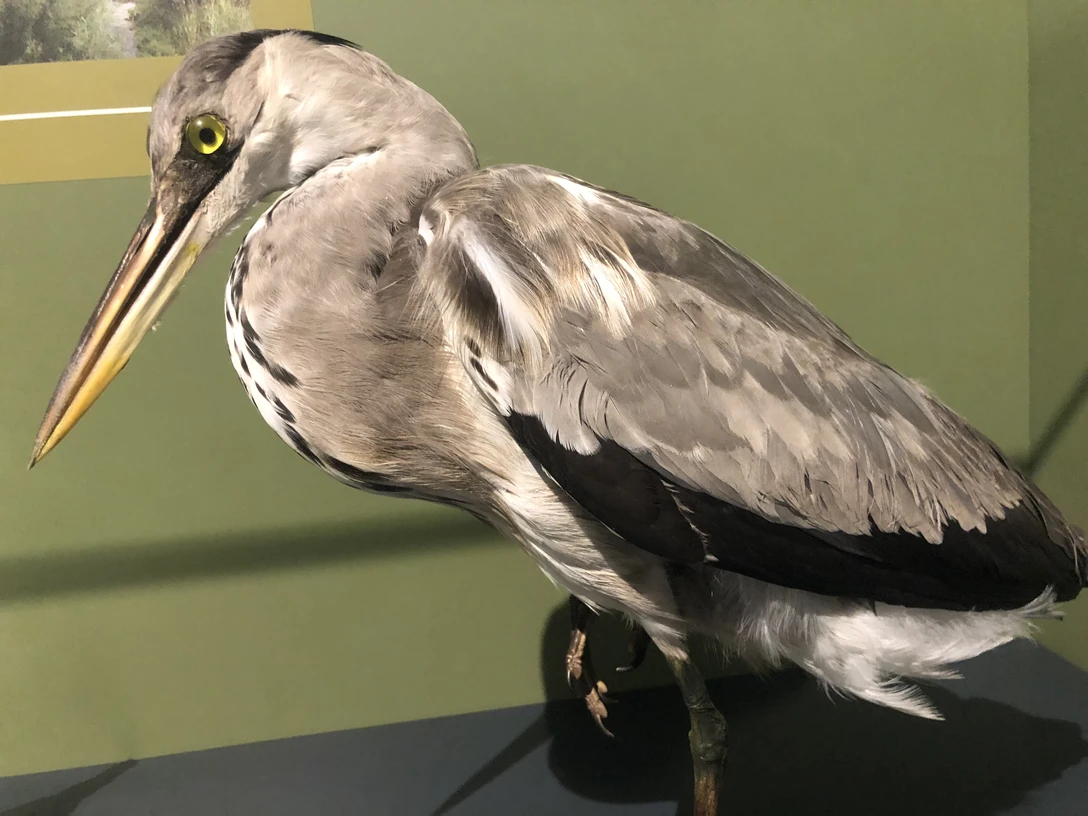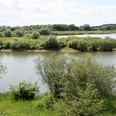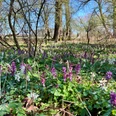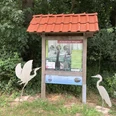The approximately 6-hectare woodland is an ash-elm riparian forest with an admixture of older oaks. The forest shows the natural tree species composition of the alluvial forests that were once widespread here - this is something special in the Weser floodplain, which is almost free of forest today.
Spring geophytes can be seen in the well-developed herb layer. These perennial herbaceous plants use the light that reaches the forest floor before the trees sprout their leaves. Here, you will find forest yellow star (Gagea lutea) alongside spotted arum (Arum maculatum) and the fragrant corydalis (Corydalis cava), which forms pink and white carpets of flowers.
The Buchhorst alluvial forest is also of particular importance for birdlife: it is home to one of the largest grey heron colonies on the Weser south of Bremen. As early as 1972, when the site was designated a protected area, 37 occupied gray heron nests could be counted. The breeding population has remained almost constant over the last few years. The forest is also home to the black kite (Milvus migrans) and the red kite (Milvus milvus), which is highly endangered in Lower Saxony - both like to build their nests in sparse stands of old wood.
In order to protect breeding birds, the protected area ordinance only allows access to the area from August 1 to January 31 of each year. In general, the wild animals living here must not be disturbed or driven away. Please also show consideration for the animals' breeding grounds and homes; eggs or nests must not be removed or damaged.
The grey heron (Ardea cinerea): This largest heron living in Europe is also commonly known as the heron. Its wingspan reaches up to 175 centimetres. During flight, the gray heron regularly lets out a loud, harsh "chräik". Grey herons usually breed in colonies on high trees, where females and males build a nest together from coarse branches and brushwood. Often last year's nests are taken over and only repaired.
In March and April, three to five eggs are hatched by both partners in 25-28 days. The young are nestlings and are fed by both parents. The parents carry the food, mainly white fish from the neighboring gravel lakes and the Weser, and regurgitate it in the nest for their young. The mortality rate of the young herons is very high at around 70 percent during the nesting period. If grey herons survive their juvenile months, they can live up to 24 years.
The grey heron is a successful fish hunter. At first, it takes things very calmly. It stands motionless in the water near the shore - until it suddenly strikes at lightning speed. It preys on smaller fish, frogs, newts, snakes and aquatic insects, as well as water rats and field mice. Occasionally it also takes eggs and young birds. To hunt fish, it can land on the water, swim for a few seconds and then fly up again. The preferred method, however, is to land on the shore and then slowly make its way into the water.
Spring geophytes can be seen in the well-developed herb layer. These perennial herbaceous plants use the light that reaches the forest floor before the trees sprout their leaves. Here, you will find forest yellow star (Gagea lutea) alongside spotted arum (Arum maculatum) and the fragrant corydalis (Corydalis cava), which forms pink and white carpets of flowers.
The Buchhorst alluvial forest is also of particular importance for birdlife: it is home to one of the largest grey heron colonies on the Weser south of Bremen. As early as 1972, when the site was designated a protected area, 37 occupied gray heron nests could be counted. The breeding population has remained almost constant over the last few years. The forest is also home to the black kite (Milvus migrans) and the red kite (Milvus milvus), which is highly endangered in Lower Saxony - both like to build their nests in sparse stands of old wood.
In order to protect breeding birds, the protected area ordinance only allows access to the area from August 1 to January 31 of each year. In general, the wild animals living here must not be disturbed or driven away. Please also show consideration for the animals' breeding grounds and homes; eggs or nests must not be removed or damaged.
The grey heron (Ardea cinerea): This largest heron living in Europe is also commonly known as the heron. Its wingspan reaches up to 175 centimetres. During flight, the gray heron regularly lets out a loud, harsh "chräik". Grey herons usually breed in colonies on high trees, where females and males build a nest together from coarse branches and brushwood. Often last year's nests are taken over and only repaired.
In March and April, three to five eggs are hatched by both partners in 25-28 days. The young are nestlings and are fed by both parents. The parents carry the food, mainly white fish from the neighboring gravel lakes and the Weser, and regurgitate it in the nest for their young. The mortality rate of the young herons is very high at around 70 percent during the nesting period. If grey herons survive their juvenile months, they can live up to 24 years.
The grey heron is a successful fish hunter. At first, it takes things very calmly. It stands motionless in the water near the shore - until it suddenly strikes at lightning speed. It preys on smaller fish, frogs, newts, snakes and aquatic insects, as well as water rats and field mice. Occasionally it also takes eggs and young birds. To hunt fish, it can land on the water, swim for a few seconds and then fly up again. The preferred method, however, is to land on the shore and then slowly make its way into the water.
Good to know
Payment methods
free of charge
Author
Mittelweser-Touristik GmbH
Lange Straße 18
31582 Nienburg/Weser
Organization
Mittelweser-Touristik GmbH
License (master data)
Mittelweser-Touristik GmbH
Nearby




